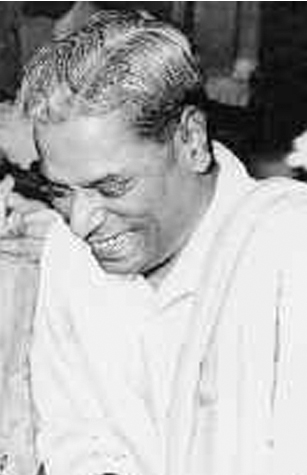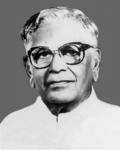
S. S. Vasan

T. T. Krishnamachari

R. Venkataramanan |
Having been a resident for 60 years of Mandaveli, the fringe or border area, I have had a vantage position to observe and participate fully in all the activities in Mylapore, the religious, social and cultural hub of the metropolis.
I have dabbled in varied activities – scouting, cricket, politics and music, apart from the media. Let me begin with my school years. P.S. High School is my alma mater. Narasimhachari taught Geography, a dull subject, most attractively. His gift was when a student would ask his neighbour with a watch about the time, Narasimhachari would unerringly tell him 13 minutes to go for the class, though he wore no watch. His mind had an electronic precision. G. Srinivasachari taught history as if it was fiction and his questions for exams were innovative and teasing.
T.A.Balasubramaniam (TAB) had a fascination for cricket and built the school team. After every victory, he would address the students in the assembly hall and his inspiring speeches would goad them to further victories. He was very humane too. When I was afflicted by toothache during the SSLC exam, he took me from my home in a rickshaw to the exam hall and was by my side with medical aid and moral support till I completed the paper. How touching of a guru! A. Narayanaswamy Iyer was a towering personality; we all thought he was a superman because he could quote Shakespeare and Milton at the drop of his turban (or, more probably, his cane, which he could wield with as much flourish as his English). Arcot Samanna was many-sided: he spoke English in the manner born, played badminton with students and was a connoisseur of music.
When Kanchi Paramacharya camped in the Sanskrit College, all of us (around 1000 students) were marched to the campus, where His Holiness advised us to grow a tuft. Instantly I twice donned the tuft, but soon enough returned to the crop (soda bottle effervescence!).
P.S. High School was rated so high that its applicants were straightaway admitted in Loyola, quite a number of them succeeding in IAS exams with distinction. The first pair of trousers I stitched was to obtain a degree at the Loyola convocation. I stuck to khadi till disillusionment overcame me.
I joined the freedom movement inspired by my school contemporary, V.R. Radharishnan, and participated in anti-British agitations. He flowered into a selfless Gandhian and socialist leader, spurning ministerial offices, which were his for the taking, had he remained in the Congress. He joined the Praja Socialist Party with his followers, including me. I was suspended from Loyola for a term for causing damage to railway property along with a group of students in an anti-British stir. A couple of them later became bureaucrats. My father was a PWD official and was warned that he would be dismissed if I persisted in my political activities. In fact, a CID detective was posted opposite my house to keep a watch on me. I had to lie low for a couple of years.
Crazy fans of poet Bharati, we founded a Bharati literary club, a Bharati bookstall, a Bharati khadi stall, and even a cricket club named after Bharati, which is 60 years old and still plays in the TNCA league.
Inspired by Kalki and Rajaji, a fund was started in memory of Kasturba Gandhi in the 1940s. S.S. Vasan made a hefty Rs. 50,000 contribution. We at the Bharati Centre made collections by selling tickets of small and big denominations. Sasi, an Ananda Vikatan journalist, came to purchase khadi. When I requested him to buy a ticket, he replied that Vasan, his boss, had made a big donation. We pleaded with him for a token response. Mad with rage, he slapped me in the presence of a crowd in front of our shop in Kapali Sannadhi Street. We called on Vasan and lodged a complaint. Sasi came to me later and said nothing would happen to him. Arya, the famous artist whose paintings of Bharati and Gandhi adorned every home and institution in Madras at the time, heard of it, took me to Sasi who was living in the corner house in South Mada Street where Ramakrishna Paramahamsa books are now sold, called out to the writer and courteously enquired about what had happened. The writer was confrontational and the fierce nationalist, Arya, rained blows on him in the presence of a huge public
S. Srinivasa Iyengar, a brilliant lawyer and one-time president of the Congress, addressed meetings often in Ranade Hall. He abhorred Gandhiji and his ways and would launch a tirade, but the audience would get restive and murmur protests. He would quickly sense the mood and declare “Gandhiji is no doubt a great man” and change the theme. He was so fast in thinking that his ideas would flow in such a cascade that his sentences would hang in mid air. As a student, I called on him often and was witness to many poor students getting donations from him to pay their fee. He appeared for Goenka of the Indian Express in many sedition cases and would tender apologies to save his client, while muttering abusive filthy words in Tamil against his client, which the English judge would not make out.
We used to call on TTK often to listen to his acerbic comments on men and affairs. He had a razor sharp intellect and would not suffer fools gladly. He would describe a Union Home Minister as a constipated cockroach or a Prime Minister as a mittaiwala. I vividly remember his anger when he came to speak at a Chitrakulam corner political meeting where hardly 15 had gathered. He called Mylaporeans snobs who would listen only to Satyamurthy.
Bhakthavatsalam was so different. Ever cool, calm, unflappable and totally detached. Even to his son, Chittaranjan, my classmate, he was distant and formal. I saw him often in his retirement years. I was witness to his giving a poor Brahmin boy a letter of recommendation for a bank job in Manipal. When he learned that the boy had no money to buy a train ticket, he provided him with funds. Few knew that he was compassionate. Contrary to belief, he was by no means affluent and led a Spartan life.
S. Sriraman rose from humble beginnings to become the President of the Board of Control for Cricket in India. He put Tamil Nadu cricket on the map of India. At a function held to felicitate him, an IAS cricket commentator said, “A streak of Visishtaadvaita runs through the TNCA like a thread beginning with C.R. Rangachari and M.J. Gopalan down to Venkataraghavan and Srikanth today.” A subtle remark but the inference is obvious.
Eminent lawyers lived in Luz or Pelathope. Subbaraya Iyer collected funds for the Madras Institute of Technology, Vivekananda College and Vidya Mandir with missionary zeal. He would take up a case only after obtaining a donation to one of these institutions. T.V. Viswanatha Sastry, his neighbour, was so stingy he would go to the High Court from Luz by tram, the cheapest transport. He reluctantly bought a car when he was elevated to the bench.
N. Raghunatha Iyer, who lived behind P.S. High School, was the best writer in English India has produced. Dr. K. Sambasivam had a huge medical practice, the rich and the poor flocking to him. He died when he was only 42. Raghunatha Iyer wrote poignantly, “The poor shamelessly exploited him.” Prof. K. Swaminathan taught us how to read poetry. I was witness to a lively conversation between him and Kalki, Swaminathan using the Tamil medium totally and Kalki only English.
In its early years, men and women could not sit together in the Rasika Ranjani Sabha to enjoy music or drama, a rope being the dividing line. During the month of Margazhi, we thronged the mada streets to listen to the moving bhajans led by Papanasam Sivan. I frequented the San Thome beach to sit near Tiger Varadhachariar who would sing inspiringly, while gulping the toddy brought by a chela from a nearby street shop in a mud pot.
The Rayar hotel in Kutcheri Road was a rendezvous for gourmets, made famous by the patronage of Vasan, Kalki and Mali.
In Mandaveli, there was Pragathi Studio where M.K. Thyagaraja Bhagavathar would swallow, non-stop, badham halwa pieces placed before him in a large brass plate. It was a sight to see K. Subramaniam with his bulk, panting for breath and walking with the camera on Brodies Road on a hot midday to direct Kachadevayani scenes.
The senior who moulded my life from my pre-teen age years was S.M. Dasan, Group Scout Master, Shivaji group. Dasan’s brother Ketharaman, brilliant in every walk of life, was a bureaucrat, untarnished by the systematic superior airs. We were neighbours in Vedachala Gardens in Mandaveli, which then marked the southern tip of metropolis, skirted by the sea on the one side and the Adyar River, which used to be the city limits, on the other. There was a good deal of greenery here with orchards and plantations.
Sir P.S. Sivaswamy Iyer, legal luminary, one of the foremost residents of Mylapore, was so highly respected by Rajaji that he once said that Sivaswamy Iyer was such an authority on defence that he was fit to be the country’s Defence Minister. An honours student, with political science as my subject, I heard a lecture by Sivaswamy Iyer in the Ranade Hall. I was shocked when he read out a whole chapter by Prof. A. Appadurai, without even crossing a t and dotting an i, which had been published in The Hindu in full as Sir P.S.S.’s speech.
Postscript: I can’t help concluding with a caustic but sad political note. Two leading Mylapore citizens, Bakthavatsalam and R. Venkataraman, were squarely responsible for the trouncing of the Congress in the 1967 election. Bakthavatsalam mishandled the anti-Hindi stir with needless firing, and R. Venkataraman misread the situation. At a Congress election meeting, I conveyed to him the public anger over poor quality ration rice supply. R.V. retorted, “You must ask the voters whether they wanted rice or democracy.” The people voted the Congress out. To make matters worse, Kamaraj claimed he could defeat the opposition relaxing in bed. Nearly forty years have passed and still the Congress is hopelessly weak. I speak from anguish, pain and sorrow as a citizen concerned over public wellbeing. Remember the Congress was founded in Mylapore.
At a function organised a few years ago by the Swarna Ananta Padmam Foundation to celebrate Mylapore, I requested a veteran journalist who spoke on the occasion for the text of his talk. With ‘Madras Week’ ahead this seems appropriate to publish excerpts from it. My only regret is I did not catch the speaker’s name. If he sees this, I hope he will respond, so that we may acknowledge him.
– The Editor
|